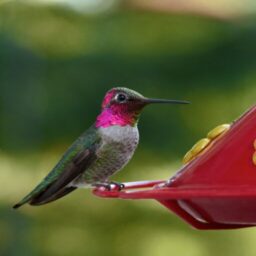Dawn in May comes very early, but I needed to set up the traps for the ongoing hummingbird banding project on our deck in the Santa Cruz Mountains. (Trapping begins 30 minutes before sunrise and continues for 5 hours of trapping, banding and recording.) No matter how early, the thought of learning more about hummingbirds would get my blood flowing and my energy up.
In March of 2007 hummingbird banding commenced and continued every two weeks for a full year of research. Rita Colwell of the Hummingbird Monitoring Network (www.hummonnet.org) had been to our home on several occasions to “pre-test” the area for potential Allen’s sightings and general ease of banding. The site passed the review and banding started with a small number of birds in the early spring. As the season progressed, we saw startling numbers of hummers at the 5 required feeders. Rufous, Allen’s and Anna’s zipped about and some chose to stay to breed. Rufous make a quick appearance and then moved on for better flowers and breeding grounds farther North. (They would reappear for a fueling stop on the return trip south.) Soon hatch-year birds were out among the adults and further taxed the feeders. During a particularly busy time, I was filling feeders every day with over 64 ounces of sugar water! (I’d also carefully planted sage and other plants to attract hummers when all feeders were full.)
The numbers we banded are staggering:
400 Anna’s, 11 Rufous, 35 Allen’s, and 1 unidentified female Selasphorus were banded for a total of 447; we recaptured 102 birds for a grand total of 549 captures.
Our research focused on gathering basic information such as age, sex, weight, bill length and reproductive evidence, especially for the Allen’s, which has been little studied. ALHUs become “trap” shy very quickly and often will not return to a feeder once it has been caught. Our likely lone breeding male did an exceptional job of managing his harem of females. Although a number of adult male ALHUs were in the yard early on, we believe the breeding bird successfully chased off other males.
Although it is hard to summarize a year’s worth of research, I can tell you what fascinated me was the movement of these birds. One week we’d trap 30 Anna’s. Two weeks later we’d trap 30 ANHUs, but only two of them would be the same birds– 28 new birds had replaced the others that were missing. I formerly believed that the vast majority of the birds that swirled around the feeders were the same birds, but that just isn’t the case. Where do all these Anna’s go? Do they go up-slope and down-slope? Do they go to Arizona as some have suggested? Do they move up and down the coast? Who knows? Maybe you can help…if you see a hummer with a band, please let us know. 831-425-0845 or Monahan@trogon.com
My many thanks to David Suddjian for recommending my house as a potential banding site!
Barbara Monahan
